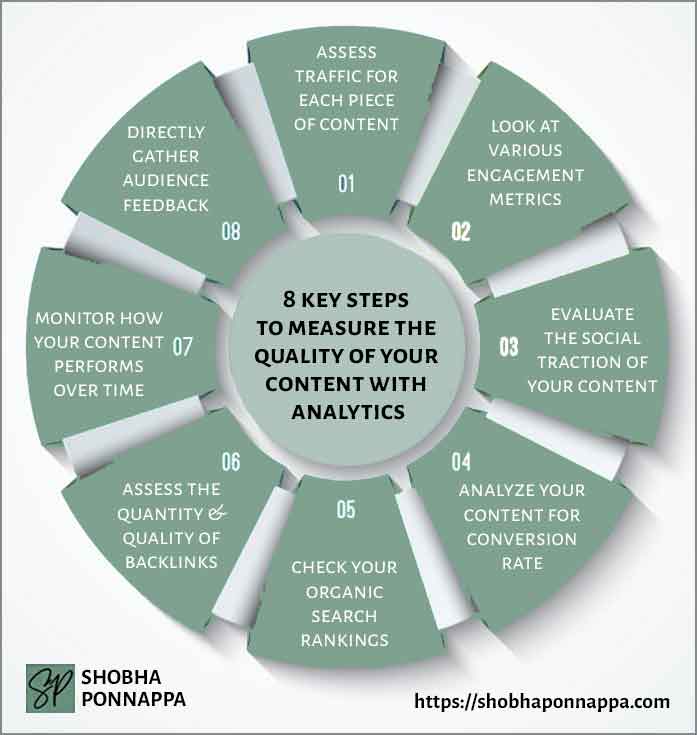
The success of content isn’t just about creativity; it’s also about its measurable impact. Understanding how your content performs is crucial, but knowing how to measure this effectively is the real challenge.
The solution lies in a strategic blend of analytics, combining conventional methods with innovative approaches.
It’s essential to balance time-tested techniques with out-of-the-box thinking to truly gauge the quality of your content.
This approach not only provides a comprehensive view of performance but also uncovers unique insights, setting the stage for content that resonates and achieves its intended goals.
Content quality, a multifaceted concept, is the cornerstone of any successful brand strategy, encompassing relevance, engagement, and value delivered to the audience. It’s not just about well-written pieces; it’s about creating content that resonates with your target audience, driving meaningful interactions and conversions.
For brands, accurately measuring content quality involves a comprehensive analysis of various metrics. Engagement rates, including time spent on page and social shares, reveal how content captivates the audience. SEO performance, indicated by search rankings and organic traffic, shows the content’s visibility and relevance to user queries.
Conversion rates further illustrate the content’s effectiveness in prompting desired actions. Additionally, content longevity and quality of backlinks provide insights into its enduring value and credibility.
These metrics, when analyzed together, offer a robust framework for brands to assess content quality, ensuring their messaging not only captures attention but also sustains interest and fosters brand loyalty.
Measuring the quality of content requires a blend of proven methods and unusual ideas, a concept central to my “Unusual By Strategy” forte. This unique approach dictates the integration of traditional analytics, such as traffic analysis, engagement metrics, and SEO performance, with innovative, less orthodox methods.
These might include examining the emotional resonance of content through sentiment analysis or exploring unconventional metrics like content’s shareability in niche online communities. The rationale behind this dual approach is to not only capture the quantitative success of content but also to tap into its qualitative aspects.
This strategy ensures a comprehensive understanding of content impact, going beyond surface-level analytics to delve into the deeper, often unexplored facets of content engagement and effectiveness.
By balancing tried-and-tested techniques with creative, unconventional metrics, a more nuanced and complete picture of content quality can be gleaned, setting the stage for truly impactful and resonant content creation.
Leveraging my 40+ years’ experience as a Brand Content Strategist with a penchant for the unusual, I have crafted eight ideas that blend time-tested approaches with innovative twists for measuring content quality through analytics. These ideas not only utilize established methods like traffic and engagement analysis but also incorporate unconventional strategies that amplify their effectiveness.
This unique blend ensures a deeper understanding of content impact, allowing for a more dynamic and holistic assessment. By integrating these novel twists, I aim to provide a comprehensive toolkit that pushes the boundaries of traditional content evaluation, making the insights gleaned both more robust and insightful.

A fundamental metric in content analytics is the assessment of traffic for each piece of content, a clear indicator of its reach and appeal. For instance, a blog post about ‘Innovative Marketing Strategies’ on a content marketing website might garner 10,000 views within the first week, signaling high interest in this topic.
Diving deeper, analyzing the sources of this traffic – whether direct, through search engines, or social media referrals – can provide insights into the audience’s behavior and preferences. This information is pivotal for content marketers as it guides future content creation, ensuring alignment with audience interests.
Additionally, comparing traffic data across different pieces of content highlights trends and preferences, revealing what resonates most with the target audience.
Such analysis not only helps in refining the content strategy but also enhances the effectiveness of marketing efforts, making content not just a tool for communication but a strategic asset in engaging and expanding the audience base. This approach, rooted in quantitative analysis, forms a solid foundation for any robust content marketing strategy, driving both relevance and impact.

Consider the idea of “Contextual Traffic Dynamics.” This unusual enhancement involves analyzing traffic not just in volume but also in context to external events or trends. By correlating traffic spikes or drops with specific industry happenings, social media trends, or even global news events, you gain deeper insight into what drives audience interest.
Applying this to the earlier example of the blog post on ‘Innovative Marketing Strategies,’ let’s suppose there was a significant traffic increase coinciding with a major social media platform’s algorithm update. This correlation suggests that readers are actively seeking content that addresses current industry shifts, enabling a more targeted and relevant content strategy. This method goes beyond traditional analytics, offering a dynamic approach to understanding audience engagement.
Delving into engagement metrics is a cornerstone in assessing content quality, providing insights into how audiences interact with your content. Imagine a series of infographics about ‘Emerging Digital Marketing Trends’ posted on a marketing blog.
By examining metrics like average time spent on these posts, the number of comments received, and the rate at which they are shared across social platforms, you gain a nuanced understanding of how compelling and relevant the content is to your audience.
For instance, if the average time spent is high but the share rate is low, it might indicate that while the content is engaging, it may not be easily shareable or relatable enough to prompt broader dissemination. In content marketing, these engagement metrics are pivotal in shaping content strategy.
They not only inform the effectiveness of current content but also guide the development of future materials, ensuring they are fine-tuned to audience preferences and behaviors, thus maximizing engagement and reach.

Consider the idea of “Emotional Resonance Tracking.” This unusual enhancement involves analyzing engagement metrics through the lens of emotional impact. By integrating sentiment analysis tools, you can gauge the emotional tone of comments and interactions, offering a deeper understanding of how content resonates on an emotional level with your audience.
Applying this to the infographics about ‘Emerging Digital Marketing Trends,’ you could assess whether comments express excitement, curiosity, or skepticism. This approach provides a richer picture of engagement, going beyond traditional metrics to uncover the emotional connection your audience has with your content, thereby enabling more emotionally attuned content strategies.
Evaluating the social traction of content is a crucial aspect of understanding its impact and reach. For example, a video series about ‘Sustainable Business Practices’ shared on a company’s social media channels can provide valuable insights.
By tracking the number of likes, shares, and comments each video receives, you gain a clear view of how engaging and relevant the content is to your audience. If certain videos in the series consistently attract more interaction, it indicates topics or formats that resonate more with viewers.
In content marketing, these social metrics are essential; they not only reflect the content’s immediate appeal but also its potential to foster community and conversation. A high level of social engagement typically correlates with increased brand visibility and authority, crucial elements in building a strong online presence.
By closely monitoring and analyzing these social interactions, marketers can fine-tune their strategies to produce content that not only captivates but also amplifies their brand’s voice in the digital arena.

Consider the idea of “Social Echo Mapping.” This unusual enhancement entails not just counting likes, shares, and comments, but also mapping the spread of your content across social networks and forums. It involves tracking how your content is being shared and discussed beyond the first layer of direct engagement.
For the ‘Sustainable Business Practices’ video series, this would mean observing how the videos are referenced in online communities, forums, or even other social media platforms. Such a mapping can reveal the content’s secondary and tertiary ripple effects, offering a deeper insight into its true social reach and influence, well beyond the immediate sphere of your direct audience.
Analyzing the conversion rate of your content is vital to understand its effectiveness in driving desired actions from your audience. Take, for instance, an eBook titled ‘The Ultimate Guide to Social Media Marketing’ offered on a digital marketing blog.
By tracking how many visitors download the eBook after reading related blog posts, you can gauge the success of your content in converting readers into leads. This conversion rate is a tangible measure of your content’s ability to not only attract but also to compel action, whether it’s signing up for a newsletter, downloading a resource, or making a purchase.
In content marketing, conversion rates offer a direct link between content engagement and business outcomes. High conversion rates indicate that the content is aligned with user needs and effectively persuades them to take the next step in their customer journey.
This metric is essential for marketers to fine-tune their content strategy, ensuring it not only informs and engages but also converts, driving tangible business results.

Consider the idea of “Predictive Conversion Modeling.” This unusual enhancement involves using advanced analytics and machine learning to predict future conversion rates based on historical data and user behavior patterns. By applying this to the ‘The Ultimate Guide to Social Media Marketing’ eBook, predictive modeling could analyze past interactions with similar content to forecast the eBook’s conversion potential.
This method allows for a proactive approach in content strategy, adjusting elements like the call-to-action or content placement based on predictive insights. Such forward-looking analysis can significantly enhance the effectiveness of content, optimizing it not just for current audience engagement but also for future conversion success.
Checking organic search engine rankings is an essential measure of content visibility and effectiveness. Imagine an article titled ‘Top 10 SEO Strategies for 2024’ on a digital marketing blog.
By monitoring its position in search engine results for relevant keywords, you can assess how well the content is optimized and its ability to attract organic traffic. High rankings typically translate to greater visibility, indicating that the content is not only well-optimized for search engines but also deemed valuable and relevant by them.
This directly impacts the content’s ability to attract and engage the target audience, a key goal in content marketing.
Regularly tracking these rankings allows for timely adjustments in SEO strategies, ensuring the content remains relevant and visible in the ever-changing landscape of search engine algorithms. Thus, maintaining and improving organic search rankings is crucial for the long-term success of content in reaching and expanding its intended audience.

Consider the idea of “Search Intent Diversification.” This enhancement involves not just focusing on the ranking for specific keywords, but also understanding the various search intents behind those keywords. For the article ‘Top 10 SEO Strategies for 2024,’ this would mean analyzing why people search for these keywords – whether for learning, service engagement, or tool comparison – and then tailoring the content to match these intents.
By aligning the article more closely with the varied reasons people search for these terms, you can improve its relevance and ranking for a broader range of search queries, thus capturing a more diverse audience segment.
Assessing the quality and quantity of backlinks is a crucial aspect of understanding the authority and influence of your content. Consider a comprehensive guide on ‘Future-Proof Marketing Strategies’ that your site publishes.
By analyzing backlinks, you can see which other sites are referencing this guide, providing insights into the content’s credibility and reach. High-quality backlinks, especially from reputable and relevant industry sites, boost your content’s authority in search engines, enhancing its overall visibility and trustworthiness.
Additionally, a diverse range of backlinks indicates a broad appeal of your content across different platforms and audiences. In content marketing, this analysis helps not just in gauging the current success of your content but also in strategizing future content development.
Effective backlink profiles can lead to higher search engine rankings, driving organic traffic and establishing your content as a go-to resource in your field. Therefore, regularly monitoring backlinks is key to maintaining and enhancing the impact and reach of your content.

Consider the idea of “Backlink Sentiment Analysis.” This unusual enhancement goes beyond traditional backlink assessment by analyzing the tone and context in which your content is mentioned on other websites. For the guide on ‘Future-Proof Marketing Strategies’, this would involve examining not just who is linking to your content, but also how they are talking about it. Are these backlinks accompanied by positive, negative, or neutral sentiments?
Understanding the emotional context of these references can provide deeper insights into your content’s perception in the industry and among peers. This advanced analysis helps in refining content strategy to enhance reputation and authority in your field further.
Monitoring content performance over time is essential for understanding its enduring value and relevance. For example, a blog post titled ‘Innovative Email Marketing Techniques’ published a year ago can offer valuable insights into content longevity.
By tracking its traffic, engagement, and conversion rates over time, you can determine whether it continues to attract and engage audiences long after its initial publication. This long-term view is critical in content marketing, as it helps identify evergreen content that consistently performs well, providing sustained value.
It also highlights topics that have lasting appeal, guiding future content creation. Additionally, observing changes in performance can signal when to update or repurpose content to maintain its relevance.
This ongoing analysis ensures that the content strategy remains dynamic, adapting to changing audience interests and market trends, and maximizes the return on investment in content creation.

Consider the idea of “Content Evolution Mapping.” This unusual enhancement involves creating a detailed timeline of each piece of content, tracking not just performance metrics over time but also changes made to the content itself. For the ‘Innovative Email Marketing Techniques’ blog post, this would mean mapping every update or tweak made since its publication against its performance metrics during the same periods.
This approach provides insights into how specific changes impact long-term content engagement and effectiveness. It offers a granular view of content adaptation, enabling a strategic approach to updates and refinements, ensuring the content continually evolves in alignment with audience needs and preferences.
Directly gathering feedback from your audience is a powerful way to measure the impact and relevance of your content. Imagine releasing a series of webinars on ‘Advanced Content Marketing Strategies.’
By soliciting direct feedback through surveys, comments, or social media polls, you gain firsthand insights into what your audience thinks about these webinars. This feedback can reveal aspects like the clarity of the information presented, the usefulness of the strategies discussed, and suggestions for improvement.
In content marketing, such direct audience input is invaluable. It not only helps in assessing the immediate reception of your content but also guides future content creation to be more aligned with audience needs and expectations.
This proactive engagement fosters a deeper connection with the audience, as they feel their opinions are valued and considered, leading to more loyal and engaged followers. Thus, directly gathering feedback is a critical component in a dynamic and responsive content marketing strategy.

Consider the idea of “Emotive Response Analysis.” This unusual enhancement goes beyond standard feedback collection by focusing on the emotional reactions of the audience. Instead of just asking for opinions or ratings, this method involves using sentiment analysis tools on feedback received, whether through comments, surveys, or social media interactions.
Applying this to the ‘Advanced Content Marketing Strategies’ webinar series, you could analyze the emotional tone of the responses to gauge not just what the audience thinks, but how they feel about the content. This approach provides deeper insights into the emotional impact of your content, enabling you to fine-tune it to resonate more strongly with your audience’s sentiments.
Analytics integration is essential: Effectively measuring the quality of content requires integrating various analytics, from traffic and engagement metrics to conversion rates and SEO performance. These data points offer a comprehensive view of content effectiveness.
Balance traditional and innovative approaches: Combining time-tested methods with innovative strategies like emotional resonance tracking or predictive conversion modeling provides deeper insights into content performance and audience engagement.
Audience feedback is invaluable: Directly gathering and analyzing audience feedback, especially through advanced techniques like emotive response analysis, is crucial for understanding the real impact of content and aligning future strategies with audience needs and preferences.

"As a Content/Brand Specialist, and SEO/UX Writer, I can help transform your brand's online presence. I can lift it with innovative ideas to take it to an enviable position. Let's collaborate to create a captivating brand story, engage your audience, boost your online visibility, and increase your ROI. Take the next step towards your brand content success and contact me today."
Shobha Ponnappa
I Bring You:
Content Marketing That’s “Unusual By Strategy” … Tips, Tricks, Tactics, Techniques, Trends, Training.
Get my weekly ContenTracker Newsletter packed with loads of content marketing ideas – proven and unusual.
Get a free download of my ebook on “50 Unusual Ways To Use AI In Content Marketing” … and transform your success.

Just fill in the form to join my community … we have big and small brands for company. You’ll stay on the speedway to growth.
KEY TOPIC CATEGORIES COVERED ON THIS SITE:
COPYRIGHT © 2025. SHOBHAPONNAPPA.COM. ALL RIGHTS RESERVED.

Just fill in this form and get this awesome guide via email. Plus … each fortnight you’ll receive my Brand Reframe Newsletter that brings you smart insights, distilled thinking, and focused brand momentum.